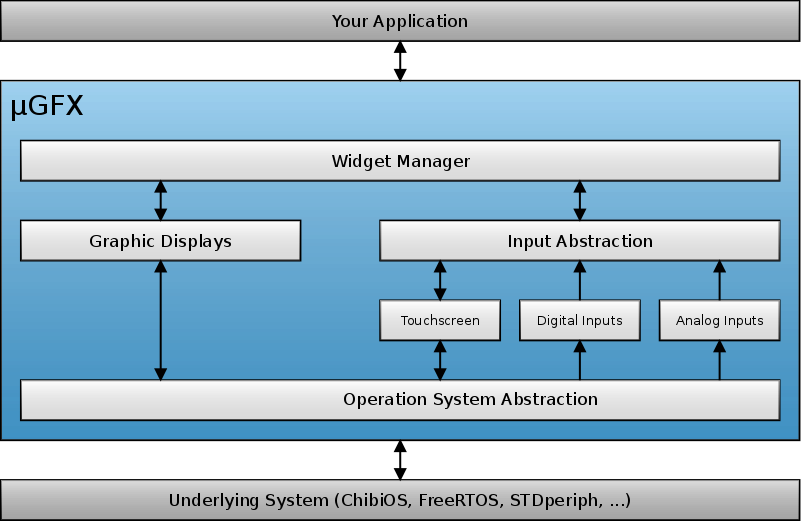Getting Started
There are two ways to get a copy of µGFX: A stable release and the latest version from the git repository. We currently strongly recommend to use the git repository. Before you start, please make sure that your application and the use of µGFX meets the license of this project. We understand that integrating uGFX into your project might be the most difficult one for most users. Please do not hesitate to ask for help should you face any issues.
Contents
Stable release
A copy of a stable release of µGFX can be downloaded from the download section.
Repository
Please note that the following guide has been written for unix-like systems using the terminal. For Windows you may use a graphical git client such as SourceTree.
µGFX is developed through a git repository hosted at bitbucket.org.
cd /path/to/your/project/resources git clone https://bitbucket.org/Tectu/ugfx ugfx
Architecture
Understanding the architecture of the µGFX library is rather important.
The library is split into different modules. Each module is responsible for a specific task such as driving an LCD, reading user inputs or handling files. There are also many modules that are available to the user but that are not necessary to build an application. Such a module is for example the GQUEUE module which provides (a)synchronous queues, buffers and more.
Integrate µGFX
After you have successfully obtained a copy of µGFX, you have to include it into your current project. Note that µGFX internally uses Makefiles.
You can find detailed descriptions for the currently supported platforms below. However, adding new platforms is fairly easy. See the GOS documentation to learn how.
Board files
Certain modules of µGFX such as the display and touchscreen drivers require a file which builds the interface to your actual hardware. This board file tells the µGFX how to talk to your hardware.
The documentation of every module shows how to create these board files.
Configuration
The entire configuration of µGFX happens in a file called gfxconf.h which you have to create. A template that can be copied can be found in /gfxconf.example.h. The configuration is crucial so please make sure that you at least scrolled once through the configuration article.
Demos
The /demos directory contains a variety of different demos, reaching from single feature (per module sorted) demos up to complete application demos. These demos can be compiled easily by adding the corresponding demo.mk file to your Makefile. For example:
include $(GFXLIB)/demos/modules/gwin/widgets/demo.mk
Note: When including a demo Makefile, you have to make sure that you don't compile any other sources with it.
Support
There are two ways to get support for your µGFX related problems:
- Free public support by the community through the discussion forum
- A support agreement / contract
Please do not hesitate to contact us if you're interested into a support agreement.
